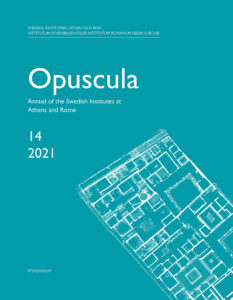 Opuscula is published by the Swedish Institutes at Athens and Rome, with the aid of a grant from the Swedish Research Council. Distributed by Eddy.se AB. View journal at ERIH PLUS. All content available with open access.
Opuscula is published by the Swedish Institutes at Athens and Rome, with the aid of a grant from the Swedish Research Council. Distributed by Eddy.se AB. View journal at ERIH PLUS. All content available with open access.
The Temple of Zeus at Lebadea. The architecture and the semantics of a colossus
By Chrysanthos Kanellopoulos (National and Kapodistrian University of Athens, Greece) & Elena Partida (Hellenic Ministry of Culture & Sports, Greece)
Abstract
The Temple of Zeus Basileus at Lebadea rests almost unknown. Its physical remains and date (not systematically explored so far) pose a riddle, as regards not only the circumstances which entailed its presumed incompletion but also the historic context in which the commencement of construction can be embedded. The dimensions of the krepis alone render this edifice highly interesting in the history of temple-building. The in situ preserved architectural elements suggest that here was begun the erection of what was at the time the largest peristasis in Mainland Greece. The temple stylobate measures 200 feet/podes in length, with a lower column diameter equal to just over two metres, and the longest interaxial spacings and corresponding architraves of its time. By increasing the length and height of the structure, the architects achieved its qualification as colossal. This qualification is revealed from the uniquefor-the-Classical-period length of 14 columns along the peristasis, with visible euthynteria and hypeuthynteria courses. As shown in this paper, this colossal structure abided by the rules of Doric design. Ascribing the unfinished state of the temple probably to financial shortcoming and/or military adventures, Pausanias did comment on its ambitious, gigantic size. The level of construction eventually reached is another focal point of our investigation. The study of the Temple of Zeus Basileus brings out the multifaceted notion of the term “monumentality”, tightly related to visual impact. One of the aims of its commissioners would have been to establish a landmark on the summit where Zeus was probably co-worshipped with Trophonios, the Boeotian hero-prophet. Since the temple in question, as we propose, most probably commemorated both a grandiose military victory in the 3rd century BC and the contemporary political situation, its imposing volume, along with the aesthetic effect of bichromy, were meant to perpetuate the overtone of these events within the ambience of the sacred Lebadea. Another facet of monumentality involves the respective building programme, and it derives from epigraphical sources, namely a contract specifying construction details, with particular instructions already at the orthostate level, denoting that accuracy in execution safeguarded the high quality of ancient Greek architecture.
Download PDF - Size: 1.46 MB - Downloads: 730 (since 2023)
Supplementary material
High-resolution versions of figs. 9-11 available, use link below.
Download PDF - Size: 8.61 MB - Downloads: 345 (since 2023)
Bibliographical information
Chrysanthos Kanellopoulos & Elena Partida, ‘The Temple of Zeus at Lebadea. The architecture and the semantics of a colossus’, Opuscula. Annual of the Swedish Institutes at Athens and Rome (OpAthRom) 14, Stockholm 2021, 363-400. ISSN: 2000-0898. ISBN: 978-91-977799-3-7. Softcover, 478 pages. https://doi.org/10.30549/opathrom-14-17

No Comments
Comments are closed.